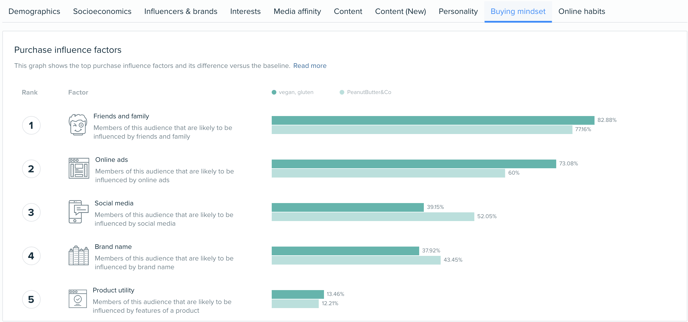This section powered by IBM Watson provides information about consumer preferences of the audiences analyzed.
There are two main categories of information: purchase influence factors and consumer behavior.
Purchase influence factors
- Brand name – members of the audience that are likely to be influenced by brand name when making product purchases
- Utility – members of the audience that are likely to be influenced by product utility when making product purchases
- Online ads – Members of the audience that are likely to be influenced by online ads when making product purchases
- Social media – members of the audience that are likely to be influenced by social media when making product purchases
- Friends and family – members of the audience that are likely to be influenced by friends and family when making product purchases
Consumer behavior
- Spur of the moment – indicates the percentage of the audience that is likely to indulge in spontaneous purchases
- Credit card – indicates the percentage of the audience that is likely to prefer using credit cards whilst shopping
- Campaigns – indicates the percentage of the audience that is likely to respond to marketing campaigns
- Targeted ads – indicates the percentage of the audience that is likely to respond to targeted advertising

How is the Buying mindset tab calculated?
Through IBM Watson, we provide insights from social media, enterprise data, or other digital communications. The service uses linguistic analytics to infer individuals' intrinsic personality characteristics from digital communications such as email, text messages, tweets, and forum posts. It infers, from potentially noisy social media, portraits of individuals that reflect their personality characteristics. It can also determine individuals' consumption preferences, which indicate their likelihood to prefer various products, services, and activities.
We feel, before jumping into how this data is calculated, we should give some background to Personality characteristics and how this is tied to consumption preferences.
Personality characteristics
The service infers personality characteristics based on three primary models:
- Big Five personality characteristics represent the most widely used model for generally describing how a person engages with the world. The model includes five primary dimensions: Agreeableness, Conscientiousness, Extraversion, Emotional range, and Openness. Each dimension has six facets that further characterize an individual according to the dimension.
- Needs describe which aspects of a product are likely to resonate with a person. The model includes twelve characteristic needs: Excitement, Harmony, Curiosity, Ideal, Closeness, Self-expression, Liberty, Love, Practicality, Stability, Challenge, and Structure.
- Values describe motivating factors that influence a person's decision-making. The model includes five values: Self-transcendence / Helping others, Conservation / Tradition, Hedonism / Taking pleasure in life, Self-enhancement / Achieving success, and Open to change / Excitement.
For more information, see IBM Watson's Personality models
Consumption preferences
Based on the personality characteristics that are inferred from the input text, the service can also return an indication of the user's consumption preferences. Consumption preferences indicate the user's likelihood to pursue different products, services, and activities. The service groups the individual preferences into eight categories: Shopping, Music, Movies, Reading and learning, Health and activity, Volunteering, Environmental concern, and Entrepreneurship. Each category contains from one to as many as a dozen individual preferences.
For more details, see IBM Watson's Consumption Preferences
How are the Purchase influence factors calculated?
Interpretation of Purchase influence factor table
The table can be interpreted quantitatively to see the weight of each purchase factor within the segment or audience and understand the member's likelihood to pursue different products, services, and activities within this audience. Use comparisons to the baseline to find the most relevant influencing factors to the segment or audience you are analyzing.
Example of use
Purchase influence factors can influence a range of decisions, starting with how to personalize engagements and interactions to better tailor your products, services, campaigns, and communications for individual clients.
How is it calculated
Through machine learning, based on IBM Watson's Personality Model, personality characteristics are inferred from the input text, the service returns an indication of the audience's consumption preferences.
How is Consumer behavior calculated?
Interpretation of Consumer behavior graph
The graphs show different ranges of how the audience members are likely to behave when purchasing online: the percentage of members of the audience that likely to prefer using credit cards for shopping, to respond to marketing campaigns and targeted advertising or are likely to indulge in the spur of the moment purchases.
Example of use
Consumer behaviour can influence a range of decisions, from tactical aspects such as relevant marketing initiatives or the creation of engaging content or ads copies to more strategic ones such as segmentation and targeting.
How is it calculated
Through machine learning, based on IBM Watson's Personality Model, personality characteristics that are inferred from the input text return an indication of the audience's consumption preferences.
Further Resources:
